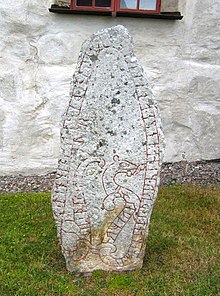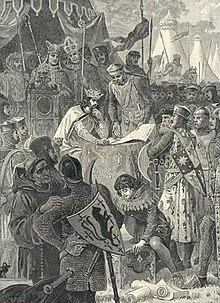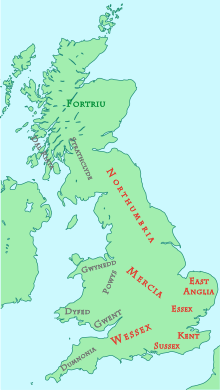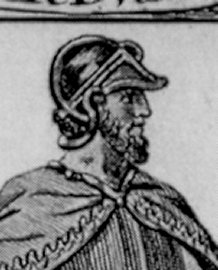Heptarchy and Christianisation
Christianisation of Anglo-Saxon England began around 600 AD, influenced by Celtic Christianity from the northwest and by the Roman Catholic Church from the southeast. Augustine, the first Archbishop of Canterbury, took office in 597. In 601, he baptised the first Christian Anglo-Saxon king, Aethelbert of Kent. The last pagan Anglo-Saxon king, Penda of Mercia, died in 655. The last pagan Jutish king, Arwald of the Isle of Wight was killed in 686. The Anglo-Saxon mission on the continent took off in the 8th century, leading to the Christianisation of practically all of the Frankish Empire by 800.
Throughout the 7th and 8th century power fluctuated between the larger kingdoms. Bede records Aethelbert of Kent as being dominant at the close of the 6th century, but power seems to have shifted northwards to the kingdom of Northumbria, which was formed from the amalgamation of Bernicia and Deira. Edwin of Northumbria probably held dominance over much of Britain, though Bede's Northumbrian bias should be kept in mind. Succession crises meant Northumbrian hegemony was not constant, and Mercia remained a very powerful kingdom, especially under Penda. Two defeats essentially ended Northumbrian dominance: the Battle of the Trent in 679 against Mercia, and Nechtanesmere in 685 against the Picts.
The so-called "Mercian Supremacy" dominated the 8th century, though it was not constant. Aethelbald and Offa, the two most powerful kings, achieved high status; indeed, Offa was considered the overlord of south Britain by Charlemagne. That Offa could summon the resources to build Offa's Dyke is testament to his power. However, a rising Wessex, and challenges from smaller kingdoms, kept Mercian power in check, and by the early 9th century the "Mercian Supremacy" was over.
This period has been described as the Heptarchy, though this term has now fallen out of academic use. The word arose on the basis that the seven kingdoms of Northumbria, Mercia, Kent, East Anglia, Essex, Sussex and Wessex were the main polities of south Britain. More recent scholarship has shown that other kingdoms were also politically important across this period: Hwicce, Magonsaete, Lindsey and Middle Anglia.
Viking challenge and the rise of Wessex
The first recorded Viking attack in Britain was in 793 at Lindisfarne monastery as given by the Anglo-Saxon Chronicle. However, by then the Vikings were almost certainly well established in Orkney and Shetland, and it is probable that many other non-recorded raids occurred before this. Records do show the first Viking attack on Iona taking place in 794. The arrival of the Vikings, in particular the Danish Great Heathen Army, upset the political and social geography of Britain and Ireland. Alfred the Great's victory at Edington in 878 stemmed the Danish attack; however, by then Northumbria had devolved into Bernicia and a Viking kingdom, Mercia had been split down the middle, and East Anglia ceased to exist as an Anglo-Saxon polity. The Vikings had similar effects on the various kingdoms of the Scots, Picts and (to a lesser extent) Welsh. Certainly in North Britain the Vikings were one reason behind the formation of the Kingdom of Alba, which eventually evolved into Scotland.
The conquest of Northumbria, north-western Mercia and East Anglia by the Danes led to widespread Danish settlement in these areas. In the early tenth century the Norwegian rulers of Dublin took over the Danish kingdom of York. Danish and Norwegian settlement made enough of an impact to leave significant traces in the English language; many fundamental words in modern English are derived from Old Norse, though of the 100 most used words in English the vast majority are Old English in origin. Similarly, many place-names in areas of Danish and Norwegian settlement have Scandinavian roots.
By the end of Alfred's reign in 899 he was the only remaining English king, having reduced Mercia to a dependency of Wessex, governed by his son-in-law Ealdorman Aethelred. Cornwall (Kernow) was subject to West Saxon dominance, and the Welsh kingdoms recognised Alfred as their overlord.
English unification
Main articles: Athelstan and Edgar of England
Alfred of Wessex died in 899 and was succeeded by his son Edward the Elder. Edward, and his brother-in-law Æthelred of (what was left of) Mercia, began a programme of expansion, building forts and towns on an Alfredian model. On Æthelred's death his wife (Edward's sister) Æthelflæd ruled as "Lady of the Mercians" and continued expansion. It seems Edward had his son Æthelstan brought up in the Mercian court, and on Edward's death Athelstan succeeded to the Mercian kingdom, and, after some uncertainty, Wessex.
Æthelstan continued the expansion of his father and aunt and was the first king to achieve direct rulership of what we would now consider England. The titles attributed to him in charters and on coins suggest a still more widespread dominance. His expansion aroused ill-feeling among the other kingdoms of Britain, and he defeated a combined Scottish-Viking army at the Battle of Brunanburh. However, the unification of England was not a certainty. Under Æthelstan's successors Edmund and Eadred the English kings repeatedly lost and regained control of Northumbria. Nevertheless, Edgar, who ruled the same expanse as Athelstan, consolidated the kingdom, which remained united thereafter.
England under the Danes and the Norman conquest
Main articles: Ethelred the Unready, Canute the Great, Eiríkr Hákonarson, and Norman conquest of England

The rune stone U 344 was raised in memory of a Viking who went to England three times.
There were renewed Scandinavian attacks on England at the end of the 10th century. Æthelred ruled a long reign but ultimately lost his kingdom to Sweyn of Denmark, though he recovered it following the latter's death. However, Æthelred's son Edmund II Ironside died shortly afterwards, allowing Canute, Sweyn's son, to become king of England. Under his rule the kingdom became the centre of government for an empire which also included Denmark and Norway.
Canute was succeeded by his sons, but in 1042 the native dynasty was restored with the accession of Edward the Confessor. Edward's failure to produce an heir caused a furious conflict over the succession on his death in 1066. His struggles for power against Godwin, Earl of Wessex, the claims of Canute's Scandinavian successors, and the ambitions of the Normans whom Edward introduced to English politics to bolster his own position caused each to vie for control Edward's reign.
Harold Godwinson became king, in all likelihood appointed by Edward the Confessor on his deathbed and endorsed by the Witan. William of Normandy, Harald III of Norway (aided by Harold Godwin's estranged brother Tostig) and Sweyn II of Denmark all asserted claims to the throne. By far the strongest hereditary claim was that of Edgar the Atheling, but his youth and apparent lack of powerful supporters caused him to be passed over, and he did not play a major part in the struggles of 1066, though he was made king for a short time by the Witan after the death of Harold Godwinson.
In September 1066, Harald III of Norway landed in Northern England with a force of around 15,000 men and 300 longships (50 men in each boat). With him was Earl Tostig, who had promised him support. Harold Godwinson defeated and killed Harald III of Norway and Tostig and the Norwegian force at the Battle of Stamford Bridge.
On September 28, 1066, William of Normandy invaded England with a force of Normans, in a campaign known as the Norman Conquest. On October 14, after having marched his exhausted army all the way from Yorkshire, Harold fought the Normans at the Battle of Hastings, where England's army was defeated and Harold was killed. Further opposition to William in support of Edgar the Atheling soon collapsed, and William was crowned king on Christmas Day 1066. For the next five years he faced a series of English rebellions in various parts of the country and a half-hearted Danish invasion, but he was able to subdue all resistance and establish an enduring regime.
Norman England
Further information: Anglo-Norman
The Norman Conquest led to a sea-change in the history of the English state. William ordered the compilation of the Domesday Book, a survey of the entire population and their lands and property for tax purposes, which reveals that within twenty years of the conquest the English ruling class had been almost entirely dispossessed and replaced by Norman landholders, who also monopolised all senior positions in the government and the Church. William and his nobles spoke and conducted court in Norman French, in England as well as in Normandy. The use of the Anglo-Norman language by the aristocracy endured for centuries and left an indelible mark in the development of modern English.
The English Middle Ages were characterised by civil war, international war, occasional insurrection, and widespread political intrigue amongst the aristocratic and monarchic elite. England was more than self-sufficient in cereals, dairy products, beef and mutton. The nation's international economy was based on the wool trade, in which the produce of the sheepwalks of northern England was exported to the textile cities of Flanders, where it was worked into cloth. Medieval foreign policy was as much shaped by relations with the Flemish textile industry as it was by dynastic adventures in western France. An English textile industry was established in the fifteenth century, providing the basis for rapid English capital accumulation.
Henry I, the fourth son of William I the Conqueror, succeeded his elder brother William II as King of England in 1100. Henry was also known as "Henry Beauclerc" (because of his education—as his older brother William was the heir apparent and thus given the practical training to be king, Henry received the alternate, formal education), worked hard to reform and stabilise the country and smooth the differences between the Anglo-Saxon and Anglo-Norman societies. The loss of his son, William Adelin, in the wreck of the White Ship in November 1120, undermined his reforms. This problem regarding succession cast a long shadow over English history.
During the confused and contested reign of Stephen, there was a major swing in the balance of power towards the feudal barons, as civil war and lawlessness broke out. In trying to appease Scottish and Welsh raiders, he handed over large tracts of land. His conflicts with his cousin The Empress Matilda (also known as Empress Maud), led to a civil war from 1139-1153 known as the Anarchy. Matilda’s father, Henry I, had required the leading barons, ecclesiastics and officials in Normandy and England, to take an oath to accept Matilda as his heir. England was far less than enthusiastic to accept an outsider, and a woman, as their ruler.
There is some evidence suggesting Henry was unsure of his own hopes and the oath to make Matilda his heir. In likelihood, Henry probably hoped Matilda would have a son and step aside as Queen Mother, making her son the next heir. Upon Henry’s death, the Norman and English barons ignored Matilda’s claim to the throne, and thus through a series of decisions, Stephen, Henry’s favourite nephew, was welcomed by many in England and Normandy as their new ruler.
On 22 December 1135, Stephen was anointed king with the implicit support of the church and nation. Matilda and her own son stood for direct descent by heredity from Henry I, and she bided her time in France. In the autumn of 1139, she invaded England with her illegitimate half-brother Robert of Gloucester. Her husband, Geoffroy V of Anjou, conquered Normandy but did not cross the channel to help his wife, satisfied with Normandy and Anjou. During this breakdown of central authority, the nobles ran amuck building adulterine castles (i.e. castles erected without government permission).
Stephen was captured, and his government fell. Matilda was proclaimed queen but was soon at odds with her subjects and was expelled from London. The period of insurrection and civil war that followed continued until 1148, when Matilda returned to France. Stephen effectively reigned unopposed until his death in 1154, although his hold on the throne was still uneasy. As soon as he regained power, he began the process of demolishing the adulterine castles, which were hated by the peasants due to their being employed as forced labor to build and maintain them. Stephen kept a few castles standing however, which put him at odds with his heir.
England under the Plantagenets
Geoffroy's son, Henry, resumed the invasion; he was already Count of Anjou, Duke of Normandy and Duke of Aquitaine when he landed in England. When Stephen's son and heir apparent Eustace died in 1153, the king reached an accommodation with Henry of Anjou (who became Henry II) to succeed Stephen and in which peace between them was guaranteed. England was part of a greater union, retrospectively named the Angevin Empire. Henry destroyed the remaining adulterine castles and expanded his power through various means and to different levels into Ireland, Scotland, Wales, Flanders, Nantes, Brittany, Quercy, Toulouse, Bourges and Auvergne.
The reign of Henry II represents a reversion in power back from the barony to the monarchical state in England; it was also to see a similar redistribution of legislative power from the Church, again to the monarchical state. This period also presaged a properly constituted legislation and a radical shift away from feudalism. In his reign new Anglo-Angevin and Anglo-Aquitanian aristocracies developed, though not to the same point as the Anglo-Norman once did, and the Norman nobles interacted with their French peers.

The signing of the Magna Carta (1215)
Henry's successor, Richard I "the Lion Heart" (also known as "The absent king"), was preoccupied with foreign wars, taking part in the Third Crusade and defending his French territories against Philip II of France.
The Kingdom of England was a sovereign state until the reign of Richard I who made it a nominal vassal of the Holy Roman Empire in 1194 as part of a ransom when he was captured after a crusade.
Richard's younger brother John, who succeeded him, was not so fortunate; he suffered the loss of Normandy and numerous other French territories following the disastrous Battle of Bouvines.
Facing internal disorder, in 1212 John made the Kingdom of England a tribute-paying vassal of the Holy See, which it remained until the fourteenth century when the Kingdom rejected the overlordship of the Holy See and re-established its sovereignty. From 1212 onwards, John had a constant policy of maintaining close relations with the Pope, which partially explains how he persuaded the Pope to reject the legitimacy of the Magna Carta.
The European wars culminated in defeat at the Battle of Bouvines (1214), which forced the king to accept an unfavourable peace with France after having failed to get help from King Mohammed el-Nasir of Morocco.[8]
- Magna Carta
The barons turned against him due to the unfavorable treaty (some had already rebelled against him after he was excommunicated), and he met their leaders along with their French and Scots allies at Runnymede, near London on 15 June 1215 to seal the Great Charter, which imposed legal limits on the king's personal powers. called in Latin Magna Carta. Because he had sealed under duress, however, John received approval from his overlord the Pope to break his word as soon as hostilities had ceased, provoking the First Barons' War and an invited French invasion by Prince Louis of France (whom the majority of the English barons had invited to replace John on the throne and had him proclaimed king in London in May 1216). John travelled around the country to oppose the rebel forces, directing, among other operations, a two-month siege of the rebel-held Rochester Castle.
John's son, Henry III, was only 9 years old when he became king (1216-1272). He spent much of his reign fighting the barons over the Magna Carta[citation needed] and the royal rights, and was eventually forced to call the first "parliament" in 1264. He was also unsuccessful on the Continent, where he endeavoured to re-establish English control over Normandy, Anjou, and Aquitaine.
His reign was punctuated by numerous rebellions and civil wars, often provoked by incompetence and mismanagement in government and Henry's perceived over-reliance on French courtiers (thus restricting the influence of the English nobility). One of these rebellions—led by a disaffected courtier, Simon de Montfort—was notable for its assembly of one of the earliest precursors to Parliament. In addition to fighting the Second Barons' War, Henry III made war against Saint Louis and was defeated during the Saintonge War, yet Louis IX did not capitalise on his victory, respecting his opponent's rights.
The reign of Edward I (reigned 1272-1307) was rather more successful. Edward enacted numerous laws strengthening the powers of his government, and he summoned the first officially sanctioned Parliaments of England (such as his Model Parliament). He conquered Wales and attempted to use a succession dispute to gain control of the Kingdom of Scotland, though this developed into a costly and drawn-out military campaign.
His son, Edward II, proved a disaster. A weak man who preferred to engage in activities like thatching and ditch-digging rather than jousting, hunting, or the usual entertainments of kings, he spent most of his reign trying in vain to control the nobility, who in return showed continual hostility to him. Meanwhile, the Scottish leader Robert Bruce began retaking all the territory conquered by Edward I. In 1314, the English army was disastrously defeated by the Scots at the Battle of Bannockburn. Edward also showered favors on his companion Piers Gaveston, a knight of humble birth. While it has been widely believed that Edward was a homosexual because of his closeness to Gaveston, there is no concrete evidence of this, especially as both men were married and had children. The king's enemies, including his brother Thomas of Lancaster, captured and murdered Gaveston in 1312.
Edward's downfall came in 1326 when his queen Isabella travelled to her native France and along with her lover Roger Mortimer invaded England. Despite their tiny force, they quickly rallied support for their cause. The king fled London and his companion since Piers Gaveston's death, Hugh Despenser, was publicly tried and executed. Edward was eventually captured and charged with breaking his coronation oath. He was deposed and remained imprisoned in Gloucestershire until he was murdered some time in the autumn of 1327, presumably by agents of Isabella and Mortimer.







.svg.png)
No comments:
Post a Comment